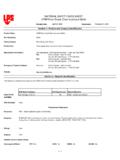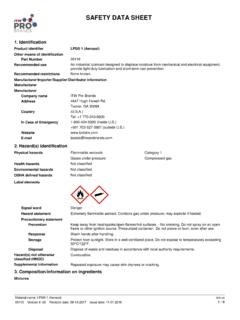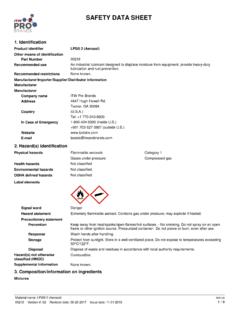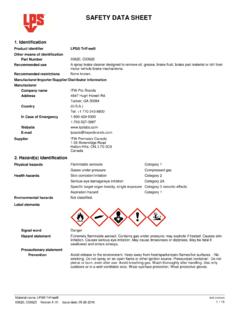Transcription of SAFETY DATA SHEET - LPS Labs
1 SAFETY data SHEET1. IdentificationLPS Tapmatic TriCutProduct identifierOther means of identification05316, 05328 Part NumberA metal-cutting fluid designed for machining hard metals such as stainless steels especially inhand-tapping useNone restrictionsManufacturer/Importer/Suppli er/Distributor informationManufacturerManufacturerCompa ny nameITW Pro BrandsAddress4647 Hugh Howell , GA 30084 Country( )Tel: +1 770-243-8800In Case of Emergency1-800-424-9300 (inside )+001 703-527-3887 (outside Hazard(s) identificationNot hazardsNot hazardsNot hazardsNot defined hazardsLabel symbolSignal statementThe mixture does not meet the criteria for statementPreventionObserve good industrial hygiene hands after away from incompatible of contents/container in accordance with local/regional/national/international (s) not otherwiseclassified (HNOC)None informationNone Composition/information on ingredientsMixturesCAS number%Chemical nameCommon name and synonyms1402738-52-6 Chlorinated Alkenes (40-52%Chlorine by wt.))
2 70 - 8068991-18-4 Fats & glyceridic oils, animal, mixedw/ vegetable oil methyl esters,sulfurized20 - 3064742-47-8 Distillates Petroleum HydrotreatedLight1 - 51 / 7 Material name: LPS Tapmatic TriCut05316, 05328 Version #: 03 Revision date: 03-03-2017 Issue date: 05-04-2016 SDS USCAS number%Chemical nameCommon name and synonyms68440-29-9 Fatty acids, tallow, methyl esters,chlorinated1 - 58013-07-8 epoxidized soybean Oil< 167784-80-9 Methyl Ester of soybean Oil< 18002-09-3 Pine Oil< 14. First-aid measuresIf symptoms develop move victim to fresh air. Get medical attention if symptoms off with soap and water. Get medical attention if irritation develops and contactRinse with water.
3 Get medical attention if irritation develops and contactIn the unlikely event of swallowing contact a physician or poison control contact with eyes may cause temporary importantsymptoms/effects, acute anddelayedTreat of immediatemedical attention and specialtreatment neededEnsure that medical personnel are aware of the material(s) involved, and take precautions toprotect information5. Fire-fighting measuresWater fog. Foam. Dry chemical powder. Carbon dioxide (CO2).Suitable extinguishing mediaDo not use water jet as an extinguisher, as this will spread the extinguishingmediaDuring fire, gases hazardous to health may be hazards arising fromthe chemicalSelf-contained breathing apparatus and full protective clothing must be worn in case of protective equipmentand precautions for firefightersContainers should be cooled with water to prevent vapor pressure build fightingequipment/instructionsUse standard firefighting procedures and consider the hazards of other involved methodsNo unusual fire or explosion hazards fire hazards6.
4 Accidental release measuresKeep unnecessary personnel away. Use personal protection recommended in Section 8 of precautions,protective equipment andemergency proceduresRefer to attached SAFETY data sheets and/or instructions for use. Stop leak if you can do so withoutrisk. Move the cylinder to a safe and open area if the leak is irreparable. Eliminate all ignitionsources (no smoking, flares, sparks, or flames in immediate area). Keep combustibles (wood,paper, oil, etc.) away from spilled material. Absorb in vermiculite, dry sand or earth and place intocontainers. Following product recovery, flush area with Spills: Wipe up with absorbent material ( cloth, fleece). Clean surface thoroughly toremove residual contamination.
5 For waste disposal, see section 13 of the and materials forcontainment and cleaning upAvoid discharge into drains, water courses or onto the precautions7. Handling and storageObserve good industrial hygiene practices. Wear appropriate personal protective equipment. Avoidcontact with eyes, skin, and clothing. Avoid prolonged exposure. Use only in well-ventilated for safe handlingStore in original tightly closed container. Store away from incompatible materials (see Section 10of the SDS).Conditions for safe storage,including any incompatibilities2 / 7 Material name: LPS Tapmatic TriCut05316, 05328 Version #: 03 Revision date: 03-03-2017 Issue date: 05-04-2016 SDS US8. Exposure controls/personal protectionOccupational exposure - OSHAV alueComponentsFormTypePEL5 mg/m3 Oil mistDistillates PetroleumHydrotreated Light (CAS64742-47-8)ACGIHV alueComponentsFormTypeTWA5 mg/m3 Oil mistDistillates PetroleumHydrotreated Light (CAS64742-47-8)No biological exposure limits noted for the ingredient(s).
6 Biological limit valuesGood general ventilation (typically 10 air changes per hour) should be used. Ventilation ratesshould be matched to conditions. If applicable, use process enclosures, local exhaust ventilation,or other engineering controls to maintain airborne levels below recommended exposure limits. Ifexposure limits have not been established, maintain airborne levels to an acceptable engineeringcontrolsIndividual protection measures, such as personal protective equipmentWear SAFETY glasses with side shields (or goggles).Eye/face protectionSkin protectionWear appropriate chemical resistant gloves. Suitable gloves can be recommended by the protectionWear suitable protective permissible levels are exceeded use NIOSH mechanical filter / organic vapor cartridge or anair-supplied protectionWear appropriate thermal protective clothing, when hazardsWhen using do not smoke.
7 Always observe good personal hygiene measures, such as washingafter handling the material and before eating, drinking, and/or smoking. Routinely wash workclothing and protective equipment to remove hygieneconsiderations9. Physical and chemical properties thresholdNot point/freezing pointNot boiling point and boilingrange400 F ( C) (estimated)Flash point> F (> C) Tag Closed Cup (estimated)Evaporation rate< 1 BuAcNot (solid, gas)Upper/lower flammability or explosive limitsFlammability limit - lower(%)Not limit - upper(%)Not limit - lower (%)Not limit - upper (%)Not pressureNot density> 1 (air = 1)Relative densityNot / 7 Material name: LPS Tapmatic TriCut05316, 05328 Version #: 03 Revision date: 03-03-2017 Issue date.
8 05-04-2016 SDS USSolubility(ies)Solubility (water)Not soluble in waterPartition coefficient(n-octanol/water)Not temperatureNot temperatureNot > 330 cP @ 104 F / 40 COther lb/galNot propertiesNot propertiesPercent volatileNot % per US State & Federal Consumer Product Regulations10. Stability and reactivityThe product is stable and non-reactive under normal conditions of use, storage and is stable under normal stabilityHazardous polymerization does not of hazardousreactionsAvoid temperatures exceeding the flash point. Contact with incompatible to avoidStrong oxidizing materialsCarbon decompositionproducts11. Toxicological informationInformation on likely routes of exposureInhalationProlonged inhalation may be contactNo adverse effects due to skin contact are contactDirect contact with eyes may cause temporary cause discomfort if swallowed.
9 However, ingestion is not likely to be a primary route ofoccupational related to thephysical, chemical andtoxicological characteristicsDirect contact with eyes may cause temporary on toxicological effectsAcute toxicityNot expected to be acutely ResultsComponentsSpeciesDistillates Petroleum Hydrotreated Light (CAS 64742-47-8)DermalAcuteLD50 Rabbit> 2000 mg/kgInhalationLC50 Rat> mg/l, 4 HoursVaporProlonged skin contact may cause temporary corrosion/irritationDirect contact with eyes may cause temporary eye damage/eyeirritationRespiratory or skin sensitizationRespiratory sensitizationNot a respiratory product is not expected to cause skin sensitizationNo data available to indicate product or any components present at greater than aremutagenic or cell mutagenicity4 / 7 Material name: LPS Tapmatic TriCut05316, 05328 Version #: 03 Revision date: 03-03-2017 Issue date: 05-04-2016 SDS USCarcinogenicityThis product is not considered to be a carcinogen by IARC, ACGIH, NTP, or Monographs.
10 Overall Evaluation of CarcinogenicityNot Specifically Regulated Substances (29 CFR )Not National Toxicology Program (NTP) Report on CarcinogensNot product is not expected to cause reproductive or developmental toxicitySpecific target organ toxicity -single exposureNot target organ toxicity -repeated exposureNot hazardNot an aspiration effectsNone informationNone Ecological informationThe product is not classified as environmentally hazardous. However, this does not exclude thepossibility that large or frequent spills can have a harmful or damaging effect on the ResultsSpecies* Estimates for product may be based on additional component data not Petroleum Hydrotreated Light (CAS 64742-47-8) mg/l, 96 hoursRainbow trout,donaldson trout(Oncorhynchus mykiss)Not inherently and degradability Bioaccumulative potentialNo data in soilOther adverse effectsNone Disposal considerationsCollect and reclaim or dispose in sealed containers at licensed waste disposal site.









